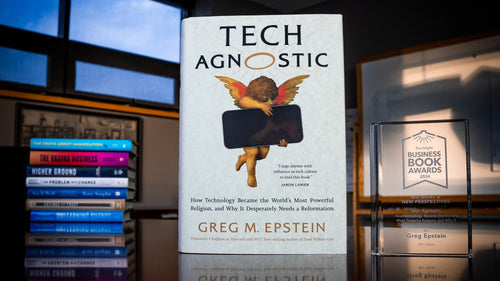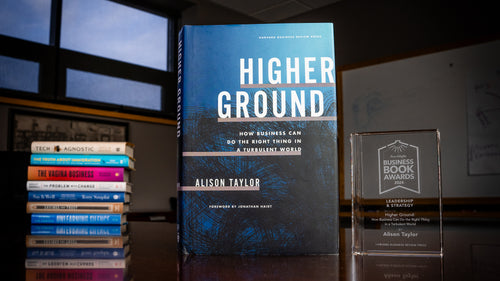Extreme Ownership: How U.S. Navy SEALs Lead and Win
 In Extreme Ownership: How U.S. Navy SEALs Lead and Win, Jocko Willink and Leif Babin share hard-hitting, Navy SEAL combat stories that translate into lessons for business and life. In this excerpt from Chapter Five, Babin describes the lessons learned from an operation in South-central Ramadi, Iraq.
In Extreme Ownership: How U.S. Navy SEALs Lead and Win, Jocko Willink and Leif Babin share hard-hitting, Navy SEAL combat stories that translate into lessons for business and life. In this excerpt from Chapter Five, Babin describes the lessons learned from an operation in South-central Ramadi, Iraq."Cover and Move"
With everything ready, we broke out of the building and emerged onto the street, our weapons pointed in all directions, ready for a fight. We quickly moved out and made our way through the streets, covering and moving as a team past Iraqi citizens who stared at us with some surprise. When aggressive men with guns pointed their weapons at them, the locals knew to keep their distance. Anyone who didn't avoid interfering with a heavily armed SEAL squad was certainly looking for trouble. Rapidly, we pushed past parked cars and piles of trash. Threats were everywhere in this urban environment. Every gate, door, and alleyway that we passed, the distant intersections down the street at ground level, and above us from every rooftop, balcony, and upstairs window—each presented the possibility of well-armed muj fighters ready to inflict horrible wounds or death upon us.
Our tactic, which we had trained for, practiced, and utilized, was a fundamental one we called "Cover and Move." Within our OP2 squad, we had four elements of smaller teams. One team covered, their weapons trained on threats, while the other team moved. Then those teams reversed roles. In this way, the teams leapfrogged in bounds, constantly utilizing Cover and Move to ensure we were prepared to fend off an attack as we maneuvered through the streets.
For about five hundred meters, OP2 moved along steadily, making our way back toward COP Falcon. Then all hell broke loose. Fully automatic gunfire erupted from the rear of the patrol. Insurgent fighters had followed us and heavily engaged us with AK-47s and PKC belt-fed machine guns, and rounds smashed into nearby walls and kicked up dust in the street right at our feet.
Immediately, we responded with withering gunfire of our own. Our SEAL machine gunners were an awesome sight to behold, fearlessly laying down fire with deadly accuracy, even as enemy rounds impacted all around them. Like a well-oiled machine, we executed a "center peel" maneuver: a coordinated tactic where two columns systematically alternate shooting at the enemy and moving away in a safe direction until able to break contact. I lobbed a few 40mm grenades over the heads of our patrol and onto enemy positions to help keep their heads down as we bounded back. Our overwhelming fire quickly repulsed the enemy attack, and we continued to a street corner that provided additional cover, moving in a hurry toward COP Falcon. Those courageous SEAL machine gunners had provided the cover fire that enabled us to move safely through the maelstrom. Within minutes, we covered the remaining distance to the COP and made our way past the Abrams tank guarding the entrance. We pushed past the concertina wire and concrete barriers into the relative safety of the U.S. Army combat outpost. We were breathing hard after running and gunning in the late morning heat with heavy gear. But we had all survived without a scratch. The LPO and I smiled and laughed at each other. We had just gotten ourselves into a solid gunfight on the street, hammered the enemy, and brought everyone back unscathed. It was awesome. We were fired up.
But already back at COP Falcon was our platoon chief. He had been with the cordon and search force and had returned earlier with Jocko and the rest of our small team of SEALs and the Iraqi soldiers. Chief wasn't happy. He pulled me aside.
"What the hell were you guys doing out there?" the chief asked sternly.
"What do you mean?" I asked, immediately getting defensive.
The chief was a hell of a battlefield leader—extraordinary in a gunfight. With a long career of nearly twenty years, he was the most experienced SEAL in the task unit, and we highly valued his guidance and mentorship. Never one to shy away from a fight, he was courageous and always eager to close with and destroy the enemy. So why now was he critical of us, particularly my leadership on the battlefield?
"What are you talking about?" I said.
"Why didn't you leave the other SEAL sniper overwatch position—OP1—in place to cover your movement back here to COP Falcon?" the chief asked.
I thought about that for a moment. My initial defensiveness wore off . He was right.
"No reason," I replied, understanding that his logic was absolutely correct. I realized my error. "I was so focused on our own squad's dilemma, I didn't think to coordinate with the other team, OP1, to work together. We absolutely should have." This was the first rule in Jocko's Laws of Combat: Cover and Move. I had broken it. We had used Cover and Move within my own immediate OP2 team, but I had forgotten about the greater team and support available. We had operated independently, failing to support or help each other. Had we left OP1 in place, they would have had an excellent vantage from the high ground and could have covered our OP2 movement much of the way as we patrolled through the dangerous streets back to COP Falcon. Once at the COP, we (OP2) could have provided additional cover for OP1 as they returned to COP Falcon.
It was foolishness not to work together. Though we were working in small teams with some distance between us we weren't on our own. We were all trying to accomplish the same mission. The enemy was out there working against us—all of us. It was essential that we support each other and work together. One element must cover so that the other element could move. Our OP2 had gotten lucky this time around, damn lucky. But my chief knew, and I now recognized, that we had taken a needless and foolish risk. We should have utilized every strength and tactical advantage possible against these ruthless enemy fighters occupying Ramadi. The most important tactical advantage we had was working together as a team, always supporting each other.
It was a rude awakening for me. I had become so immersed in the details, decision points, and immediate challenges of my own team that I had forgotten about the other team, what they could do for us and how we might help them.
Going forward I never forgot my chief's guidance. We utilized the principle of Cover and Move on every operation: all teams working together in support of one another. That realization and the lesson learned implemented no doubt saved lives, greatly reduced casualties and enabled us to more effectively accomplish our mission and win.
PRINCIPLE
Cover and Move: it is the most fundamental tactic, perhaps the only tactic. Put simply, Cover and Move means teamwork. All elements within the greater team are crucial and must work together to accomplish the mission, mutually supporting one another for that singular purpose. Departments and groups within the team must break down silos, depend on each other and understand who depends on them. If they forsake this principle and operate independently or work against each other, the results can be catastrophic to the overall team's performance.
Within any team, there are divisions that arise. Often, when smaller teams within the team get so focused on their immediate tasks, they forget about what others are doing or how they depend on other teams. They may start to compete with one another, and when there are obstacles, animosity and blame develops. This creates friction that inhibits the overall team's performance. It falls on leaders to continually keep perspective on the strategic mission and remind the team that they are part of the greater team and the strategic mission is paramount.
Each member of the team is critical to success, though the main effort and supporting efforts must be clearly identified. If the overall team fails, everyone fails, even if a specific member or an element within the team did their job successfully. Pointing fingers and placing blame on others contributes to further dissension between teams and individuals. These individuals and teams must instead find a way to work together, communicate with each other, and mutually support one another. The focus must always be on how to best accomplish the mission.
Alternatively, when the team succeeds, everyone within and supporting that team succeeds. Every individual and every team within the larger team gets to share in the success. Accomplishing the strategic mission is the highest priority. Team members, departments, and supporting assets must always Cover and Move—help each other, work together, and support each other to win. This principle is integral for any team to achieve victory.
Excerpted from Extreme Ownership: How U.S. Navy SEALs Lead and Win by Jocko Willink and Leif Babin
Published by St. Martin's Press.
Copyright 2015, All rights reserved.
ABOUT THE AUTHORS
JOCKO WILLINK served 20 years as a Navy SEAL. He was in combat in Iraq during the Battle of Ramadi, a conflict that resulted in numerous medals for his efforts. After his tours, Willink served as a Navy SEAL instructor before forming Echelon Front with Leif Babin, a leadership training group that uses the lessons and expertise the pair learned as SEALs to train leaders beyond the military. Willink lives in San Diego, California.LEIF BABIN served 9 years as a Navy SEAL. He was in combat in Iraq during the Battle of Ramadi, a conflict that resulted in numerous medals for his efforts. After his tours, Babin served as a Navy SEAL instructor before forming Echelon Front with Jocko Willink, a leadership training group that uses the lessons and expertise the pair learned as SEALs to train leaders beyond the military. Babin lives in Brooklyn, New York.



